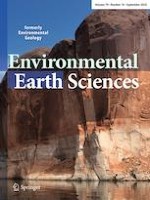01-09-2020 | Original Article
Characteristics of soil CO2 under different conditions and its influence on water chemical composition: an experimental and modeling study in the laboratory
Published in: Environmental Earth Sciences | Issue 18/2020
Log inActivate our intelligent search to find suitable subject content or patents.
Select sections of text to find matching patents with Artificial Intelligence. powered by
Select sections of text to find additional relevant content using AI-assisted search. powered by
